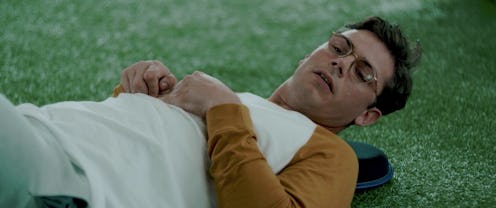Entertainment
'Special' Debunks A Huge Misconception About Cerebral Palsy Within Two Minutes Of The Show

In the opening scene of Ryan O'Connell's new Netflix series, Special, he trips and falls flat on his face. A kid on a scooter asks if he needs help, but O'Connell — who plays a semi-autobiographical version of himself also named Ryan — replies that he's fine, then gets up to walk away. Still, the kid keeps pressing. "You're walking funny," he shouts. "You need to go to the hospital, mister." Ryan, clearly exasperated, dryly explains that he has cerebral palsy (CP), "a disability resulting from damage to the brain before, during, or shortly after birth, and outwardly manifested through muscular coordination." The kid screams and rides away on his scooter. Ryan stares blankly into the distance after him. You get the sense that this isn't an isolated encounter.
A second later, the show cuts to Ryan at a physical therapy session, where his trainer is helping to stretch out his tight limbs. While laying on the ground, Ryan looks over his shoulder at Bob, who's doing PT from his automatic wheelchair and laughing with his friends. "I'm so jealous of Bob," Ryan tells his trainer, who looks at him in confusion. "I'm not able-bodied enough to be in the mainstream world, but I'm not disabled enough to be able to hang out with the cool PT crowd ... at least Bob knows where he belongs."
As shown by this moment, Ryan sees his disability as existing in a gray area: he still has to confront the stigma associated with his cerebral palsy, like with the kid on the street, but he also doesn't feel accepted by the disabled community, either. That doesn't mean that his experience is harder (or easier) than those with more severe cerebral palsy, just that it's different — which ties into one of the biggest misconceptions about the condition. As explained on the Cerebral Palsy Group's website, a myth about CP is that it's the same for everyone, when in actuality, it's an umbrella term. There are four main types of CP, and "within each is a wide range of symptoms and severities," according to the site.
However, because people with disabilities are still so under-represented on television, stories like Ryan's are rarely, if ever, portrayed. According to USA Today, people with disabilities made up nearly 20% of America's population in 2017, yet only 2% of TV characters had disabilities. And of those characters, 95% percent were played by non-disabled actors. Special is not the first of its kind — Speechless, for example, centers around JJ, a teenager with cerebral palsy played by Micah Fowler, an actor with cerebral palsy. But JJ is non-verbal and uses a wheelchair; cerebral palsy affects him much differently than it affects Ryan. Having a disability is not a singular experience, and Special is helping to show that.
"I wanna reach as many people as possible because if this show had come out when I was a teenager, it would've saved my f*cking life," O'Connell told Vulture. "When you don't see yourself being reflected back at you, you're implicitly told that you don't matter. That your life does not matter, it's not worth being told, it's not worth being discussed. And that f*cks with you on such a deep level."
Case in point: O'Connell struggled with internalized ableism throughout his life, so much so that he pretended he didn't have a disability for years. After getting hit by a car at 20, people assumed his limp was from the accident, and he didn't correct them. He was caught in an in-between space, which made him feel isolated, invisible, and like he had to hide who he really is. Being able to look to a show like Special could have changed that. And hopefully, for other people like Ryan, it will.